NCERT Solutions for Class 12 Macro Economics Chapter – 9 Foreign Exchange Rate
NCERT TEXTBOOK QUESTIONS SOLVED
Question 1. How is exchange rate determined under a flexible exchange rate regime? [6 Marks]
Or
How is foreign exchange rate determined? Explain with diagram.
Or [AI 2004; CBSE 06 q How is exchange rate determined in a foreign exchange market? Explain.[AI 2013 (Set 1)]
Answer:
- Exchange rate in a free exchange market is determined at a point, where demand for foreign exchange is equal to the supply of foreign exchange.
-
Let us assume that there are two countries – India and U.S.A – and the exchange rate of their currencies i.e., rupee and dollar is to be determined.
Presently, there is floating or flexible exchange regime in both India and U.S.A. Therefore, the value of currency of each country in terms of the other currency depends upon the demand for and supply of their currencies. - In the above diagram, the price on the vertical axis is stated in terms of domestic currency (that is, how many rupees for one US dollar). The horizontal axis measures the quantity demanded or supplied.
-
In the above diagram, the demand curve [D$] is downward sloping. This means that less foreign exchange is demanded as the exchange rate increases. This is due to the fact that the rise in price of foreign exchange increases the rupee cost of foreign goods, which make them more expensive. As a result, imports decline. Thus, the demand for foreign exchange also decreases.
The supply curve [S$] is upward sloping which means that supply of foreign exchange increases as the exchange rate increases. This makes home country’s goods become cheaper to foreigners since rupee is depreciating in value. The demand for our exports should therefore increase as the exchange rate increases. The increased demand for our exports translates into greater supply of foreign exchange. Thus, the supply of foreign exchange increases as the exchange rate increases.
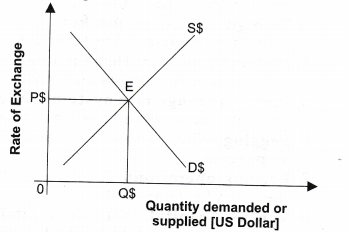 /li>
/li>
- The intersection of the supply and demand curves determine equilibrium exchange rate (OP$) and equilibrium quantity [OQ$] of foreign currency i.e., US [$].
Question 2. Differentiate between devaluation and depreciation. [3 Marks]
Answer:


Question 3. Are the concepts of demand for domestic goods and domestic demand for goods the same? [3 Marks]
Answer:
- Demand for domestic goods and domestic demand for goods are two different concepts.
- Demand for domestic goods is a demand for goods made by both domestic and foreign countries.
- Domestic demand for goods is a demand for goods by our own country for goods ..which may be produced in foreign countries.
Question 4. Would the central bank need tointervene in a managed floating system? Explain why? [3 Marks]
Answer:
- In a managed floating system a central bank of a country has freedom to bring change in the exchange rate within certain limits.
- A country is allowed after information to the IMF to bring a certain limited amount of change in the rate of exchange.
- A central bank cannot bring change in its exchange rate by more than 10%. For it, permission of IMF is necessary.
MORE QUESTIONS SOLVED
I. Very Short Answer Type Questions (1 Mark)
Question 1
. What is foreign exchange?[CBSE AI 2011, 04]
Answer:
Foreign exchange refers to all the currencies of the rest of the world other than the domestic currency of the country. For example, in India, US dollar is foreign exchange.
Question 2. What is meant by foreign exchange rate? [CBSE 2004,05,06,09 2011, Sample Paper 2010]
Answer:
The rate at which one currency is exchanged for another is called foreign exchange rate.
Question 3. What is meant by foreign exchange market?
Answer:
Foreign exchange market is the market where foreign currencies are bought and sold.
Question 4. Define flexible exchange rate system.[CBSE 2008]
Answer:
Flexible exchange rate system refers to a system in which the exchange rate of different currencies is determined by the forces of demand and supply in foreign exchange market.
Question 5. The price of 1 US Dollar has fallen from Rs. 50 to Rs. 48. Has the Indian currency appreciated or depreciated?[CBSE Sample Paper 2010]
Answer: I
ndian currency has appreciated.
II. Multiple Choice Questions (1 Mark)
Question
1. Which function of foreign exchange market protects against the foreign exchange risk?
(a) Credit function
(b) Hedging function
(c) Transfer function
(d) All of them
Answer:
(b)
Question 2. Reduction in the value of domestic currency by the government is called
(a) depreciation (b) devaluation
(c) revaluation (d) appreciation
Answer:
(b)
Question 3. Reduction in the value of domestic currency through market forces is called ………….
(a) depreciation (b) devaluation
(c) revaluation (d) appreciation
Answer:
(a)
Question 4. Increase in the value of domestic currency by the government is called
(a) depreciation (b) devaluation
(c) revaluation (d) appreciation
Answer:
(c)
Question 5. Increase in the value of domestic currency through market forces is called _______ .
depreciation (b) devaluation
revaluation (d) appreciation
Answer:
(d)
Question 6. What will be the effect on exports if foreign exchange rate increases? (a) Increases (b) Decreases
(c) Remains constant (d) None of them
Answer:
(a)
Question 7. Foreign exchange is demanded by………………..
(a) domestic residents to purchase goods and services from other countries
(b) sending gifts and grants to foreign countries (abroad)
(c) the domestic residents to purchase financial assets in a particular countiy
(d) all of them
Answer:
(d)
Question 8. The supply of foreign exchange comes from…………
(a) the foreigners purchasing home country’s goods and services through exports
(b) the foreigners who invest in home country through joint ventures or through financial market operations
(c) currency dealers and speculators.
(d) all of them
Answer:
(d)
Question 9. Buyers and sellers of foreign exchange are _______ .
(a) central banks
(b) commercial banks
(c) brokers (d) all of them
Answer:
(d)
Question 10. Which exchange rate measures the
average relative strength of a given currency with respect to other currencies without eliminating the effect of change in price?
(a) Nominal exchange rate
(b) Nominal effective exchange rate
(c) Real exchange rate
(d) Real effective exchange rate
Answer:
(b)
Question 11. When one country manipulates exchange rate against the interest of other country, is known as ……………..
(a) managed floating ( b) dirty floating
(c) wide band (d) crawling peg
Answer:
(b)
Question 12. Other things remaining the unchanged, when in a country the price of foreign currency rises, national income is: (Choose the correct alternative) [CBSE Delhi 2015]
(a) Likely to rise (b) Likely to fall
(c) Likely to rise or to fall
(d) Not affected
Answer:
(a)
Question 13. Other things remaining the same, when in a country the market price of foreign currency falls, national income is likely: (Choose the correct alternative) [AT 2015]
(a) to rise (b) to fall
(c) to rise or to fall
(d) to remain unaffected
Answer:
(b)
Short Answer Type Questions (3-4 Marks)
Question 1
. State four sources of demand of foreign exchange.[CBSE 2004, 05, 05C, 07; A 05, 10] Or
Give three reasons why people desire to have foreign exchange.
Or [CBSE 2005]
What are the sources of demand for foreign exchange?
Answer:
The demand (or outflow) of foreign exchange comes from the people who need it to make payments in foreign currencies. It is demanded by the domestic residents for the following reasons:
- Imports of Goods and Services: When India import goods and services, foreign exchange is demanded to make the payment for imports of goods and services.
- Tourism: Foreign exchange is demanded to meet expenditure incurred in foreign tours.
- Unilateral Transfers sent abroad: Foreign exchange is required for making unilateral transfers like sending gifts to other countries.
- Purchase of assets in foreign countries: It is demanded to make payment for purchase of assets, like land, shares, bonds, etc. in foreign countries.
Question 2. What are the functions of a foreign exchange market?
Answer:
- Transfer Function: Transfer function refers to transferring of purchasing power among countries.
- Credit Function: It implies provision of credit in terms of foreign exchange for the export and import of goods and services across different countries of the world.
- Hedging Function: Hedging function pertains to protecting against foreign exchange risks. Where Hedging is an activity which is designed to minimize the risk of loss.
Question 3. Why does demand for foreign exchange rise when its price falls?
Or [AI 2006, 08, 10] What are the reasons for ‘Rise in Demand’ for Foreign Currency?
Answer:
The demand for foreign currency rises in the following situations:
-
When price of a foreign currency falls, imports from that, foreign, country become cheaper. So, imports increase and hence, the demand for foreign currency rises.
For example, if price of 1 US dollar falls from Rs 60 to T 55, then imports from The USA will increase as American goods will become relatively cheaper. It will raise the demand for US dollar. - When a foreign currency becomes cheaper in terms of the domestic currency, it promotes tourism to that country. As a result, demand for foreign currency rises.
- When price of a foreign currency falls, its demand rises as more people want to make gains from speculative activities.
Question 4. When price of a foreign currency rises, its demand falls’. Explain why?
Or [CBSE 2011]
Explain relation between foreign exchange rate and demand for it.
Or [CBSE 2004q Why demand curve of foreign exchange is downward sloping?
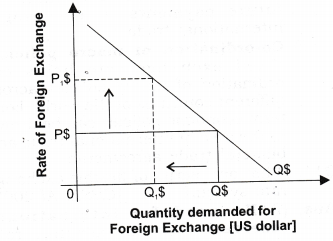
Answer:
- Demand curve of foreign exchange slopes downwards due to inverse relationship between demand for foreign exchange and foreign exchange rate.
- In figure, demand for foreign exchange (US dollar) and rate of foreign exchange are shown on the horizontal axis and vertical axis respectively.
- The demand curve [US$] is downward sloping. It means that less foreign exchange is demanded as the exchange rate increases.
- This is due to the fact that rise in the price of foreign exchange increases the rupee cost of foreign goods, which make them more expensive. As a result, imports decline. Thus, the demand for foreign exchange also decreases.
Question 5. State four sources of supply of foreign exchange.
[CBSE 2004, 05, 05C, 07, 10; AI 05] Or
What are the sources for supply of foreign exchange?
Answer:
The supply (inflow) of foreign exchange comes from the people who receive it due to the following reasons.
- Exports of goods and services :Supply of foreign exchange comes through exports of goods and services.
- Foreign investment: The amount, which foreigners invest in their home country, increases the supply of foreign exchange.
- Remittances (unilateral transfers) from abroad: Supply of foreign exchange increases in the form of gifts and other remittances from abroad.
- Speculation: Supply of foreign exchange comes from those who want to speculate on the value of foreign exchange.
Question 6. What are the reasons of ‘rise in supply’ of foreign currency?
Or
Why does a rise in foreign exchange rate cause a rise in foreign exchange supply? [CBSE 2006, 08]
Or
When exchange rate of a foreign currency rises, its supply also rises. How? Explain. [CBSE 2008]
Answer:
The supply of foreign currency rises in the following situations:
- When price of a foreign currency rises, domestic goods become relatively cheaper. It induces the foreign country to increase their imports from the domestic country. As a result, supply of foreign currency rises. For example, if price of 1 US dollar rises from Rs 60 to Rs 65, then exports to USA will increase as Indian goods will become relatively cheaper. It will raise the supply of US dollars.
- When price of a foreign currency rises,foreign direct investment (FDI) from rest of the world increases, which will increase the supply for foreign exchange.
- When price of a foreign currency rises, also supply of foreign currency rises as people want to make gains from speculative activities.
Question 7. Why supply curve of foreign exchange is upward sloping?
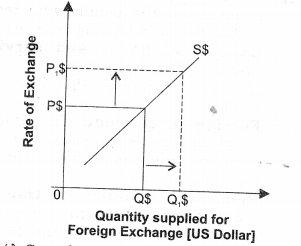
Answer:
- Supply curve of foreign exchange slopes upwards due to positive relationship between supply for foreign exchange and foreign exchange rate, which means that supply of foreign exchange increases as the exchange rate increases.
- This makes home country’s goods become cheaper to foreigners since rupee is depreciating in value. The demand for our exports should therefore increase as the exchange rate increases.
- The increased demand for our exports will translate into greater supply of foreign exchange. Thus, the supply of foreign exchange increases as the exchange rate increases.
Question 8. Explain the effect of depreciation of domestic currency on exports.
[A7 2013 (Set I), Sample Paper 2013]
Answer:
Depreciation of domestic currency means a fall in the price of domestic currency (say, rupee) in terms of a foreign currency (say, $). It means, with the same amount of dollars, more goods can be purchased from India, i.e., exports to USA will increase as they will become relatively cheaper.
Question 9. Explain the effect of appreciation of domestic currency on imports.
[CBSE 2013 (Set I), Sample Paper 2013)]
Answer:
Appreciation of domestic currency means a rise in the price of domestic currency (say, rupee) in terms of a foreign currency (say, $). Now, one rupee can be exchanged for more $, i.e., with the same amount of money, more goods can be purchased from the USA. It leads to increase in imports from the USA as American goods will become relatively cheaper.
Question 10. What are the merits of fixed exchange rate system? [CBSE 2009]
Answer:
- Stability: It ensures stability, in the international money market/ exchange market. Day to day fluctuations are avoided. It helps formulation of long term economic policies, particularly relating to exports and imports.
- Encourages international trade: Fixed exchange rate system implies low risk and low uncertainty of future payments. It encourages international trade.
- Co-ordination of macro policies: Fixed exchange rate helps co¬ordination of macro policies across different countries of the world. Long term economic policies can be drawn in the area of international trade and bilateral trade agreements.
Question 11. What are merits of flexible exchange rate system? [CBSE, AI 2009]
Answer:
- No need for international reserves: Flexible exchange rate system is not to be supported with international reserves.
- International capital movements: Flexible exchange rate system enhances movement of capital across different countries of the world. This is due to the fact that member countries are no longer required to keep huge international reserves.
- Venture capital: Flexible exchange rate promotes venture capital in foreign exchange market. Trading in international currencies itself becomes an important economic activity.
Question 12. Differentiate between fixed exchange rate and flexible exchange rate? [AI 2015]
Answer:
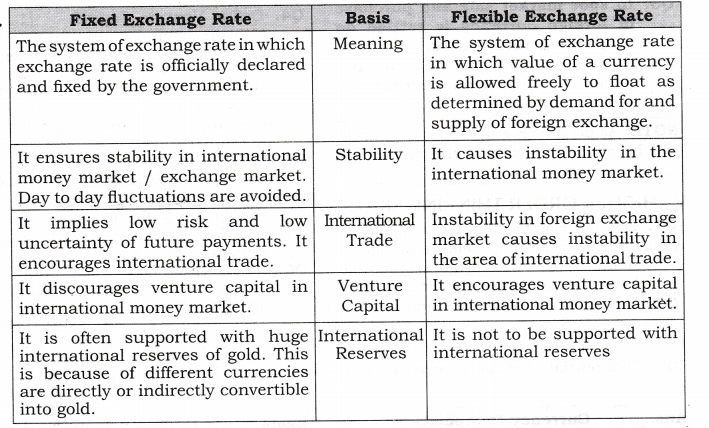
Question 13. Explain the meaning of Managed Floating Exchange Rate? [AI 2015]
Answer:
- Managed floating exchange rate is a mixture of a flexible exchange rate (the float part) and a fixed exchange rate (the Managed part).
- In other words, it refers to a system in which foreign exchange is determined by free market forces (demand and supply forces), which can be influenced by the invention of the central bank in foreign exchange market.
- Under this system, also called Dirty floating, central banks intervene to buy or sell foreign currencies in an attempt to stabilise exchange rate movements in case of extreme appreciation or depreciation.
IV. True Or False
Are the following statements true or false? Give reasons.
Question
1. An increase in demand for imported goods raises the supply for foreign exchange.
Answer: False.
Supply of foreign exchange will decrease in order to make the payment for imported goods.
Question 2. Depreciation of Indian rupees will occur when Rs. 55 have to be paid to exchange one US $ instead of present rate of Rs. 50/$.
Answer:
True
. In case of depreciation, more rupees have to be paid to exchange one US dollar, i.e., greater than Rs. 50/$.
Question 3. Appreciation of domestic currency leads to rise in imports.
Answer:
True.
Appreciation of domestic currency makes foreign goods relatively cheaper, which leads to increase in imports.
Question 4. Revaluation and appreciation of currency are one and the same thing.
Answer:
False.
Revaluation refers to increase in the value of domestic currency by the government under fixed exchange rate. On the other hand, currency appreciation refers to increase in the value of domestic currency in terms of foreign currency under flexible exchange rate system.
Question 5. In spot market sale and purchase of foreign currency is settled on a specified future date.
Answer:
False.
In spot market sale and purchase of foreign currency is settled immediately.
NOTE:
As per CBSE guidelines, no marks will be given if reason to the answer is not explained..
V. Higher Order Thinking Skills
Question
1. Define pegging operations. [1 Mark]
Answer:
Pegging operations refer to all efforts made by the central government to keep the rate of exchange stable.
Question 2. Define devaluation of currency. [1 Mark]
Answer:
Devaluation refers to decrease in the value of domestic currency by the government. It is a part of fixed exchange rate.
Question 3. Define revaluation of currency.
Answer:
Revaluation refers to increase in the value of domestic currency by the central government. It is a part of fixed exchange rate.
Question 4. Define Venture Capital. [1 Mark]
Answer:
Venture capital in the international money market refers to investments in the purchase of foreign exchange in the international money market with a view to earning profits. Fixed exchange rate system discourages such investments.
Question 5. What is managed floating rate?[CBSE 2010 ] [1 Mark]
Answer:
Managed floating exchange rate is a mixture of a flexible exchange rate (the float part) and a fixed exchange rate( the Managed part).
Question 6. Name the market exchange rate system in which a central bank can actively intervene.[Sample Paper 2013] [1 Mark]
Answer:
Managed Floating Exchange rate.
Question 7. Differentiate between Currency Depreciation and Currency Appreciation.[3 Marks]
Answer:
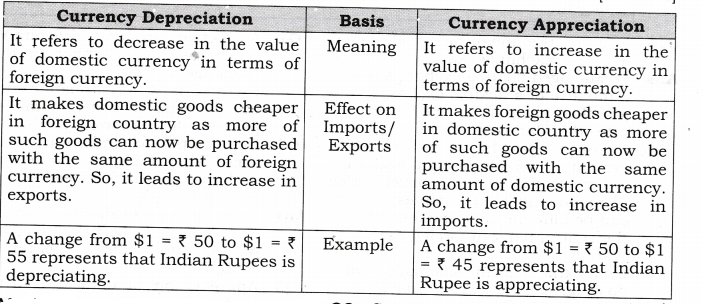
VI. Value Based Questions
Question
1. Do you think that a rise in BPO services a good source of supply of foreign currency? [1 Mark]
Answer:
Yes, because it is a export of services and good source of foreign currency.
Value:
Critical Thinking
Question 2. Suppose the present foreign exchange rate is 1$ = Rs 50 and if it rises to 1$ = Rs 60 should central bank intervene in the foreign exchange rate? [ 1 Mark]
Answer:
Yes, Central Bank should intervene in order to safeguard the interest of the importers.
Value: Creative Thinking
Question 3. What impact will fall on the expenditure of an American citizen who comes to India for Medical treatment if foreign rate is increased?
[1 Mark]
Answer:
Expenditure on treatment will reduce because by the increasing foreign exchange rate, his purchasing power will increase.
Value:
Empathy
Question 4. Why did India devalue its currency in 1991? [1 Mark]
Answer:
India devalued its currency in 1991 to increase the flow of foreign exchange reserve.
Value:
analytic
VII. Application Based Questions
Question 1
. How can Reserve- Bank of India help in bringing down the foreign exchange rate which is very high?[AI 2013 (Set 1)] [1 Mark]
Answer:
Reserve Bank of India can start selling the foreign currency from its reserves to increase its supply.
Question 2. What is the role of a Central Bank in the following exchange rate?[3 Marks]
(a) Fixed exchange
(b) Floating exchange
(c) Managed floating [CBSE Sample Paper 2014]
Answer:
The role of the Central Bank in maintaining the foreign exchange rates under different regimes is:
- Fixed exchange rate system: A Central Bank actively uses its foreign currency reserves to maintain the officially determined exchange rate.
- Floating exchange rate system: A Central Bank does not maintain any reserves of foreign currency as the market automatically adjusts to determine the market driven exchange rate
- Managed Floating: A Central Bank enters the foreign exchange market to buy/sell foreign currency in order to control fluctuations and volatility in the market.
Question 3. ‘Devaluation and Depreciation of currency are one and the same thing’. Do you agree?
How do they affect the exports of a country? [CBSE Sample Paper 2016] [3 Marks]
Answer:
- Devaluation refers to reduction in price of domestic currency in terms of all foreign currencies under fixed exchange rate regime, i.e., (It takes place due to government) .
- Depreciation refers to fall in market price of domestic currency in terms of a foreign currency under flexible exchange rate regime, i.e., (It takes place due to market forces of demand and supply)
- Currency Depreciation and Currency Devaluation may result into increase in exports of the goods and services from the country since it would increase the global competiveness of the goods.
NCERT Solutions Accountancy Business Studies Macro Economics Commerce